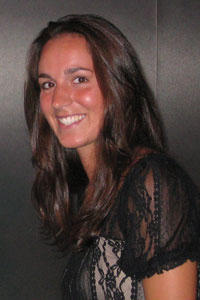She loves helping patients in their battles against cancer
 Sarah Costlow ’09, a double major in English and French who interned with the Office of Public Information during the fall 2007 semester, writes about her recent conversation with biology graduate Diana Crai ’06.
Sarah Costlow ’09, a double major in English and French who interned with the Office of Public Information during the fall 2007 semester, writes about her recent conversation with biology graduate Diana Crai ’06.
I talked to Diana Crai ’06 recently to find out what it is like for her working at Weill Cornell-New York Presbyterian Hospital. She said she works specifically in an immunopathology lab doing a specialized form of leukemia and lymphoma diagnosis. She usually does rounds in the mornings with the doctors dealing with clinical cases, but also works on research cases. She is also responsible for getting updates on the status of patients who have received chemotherapy or have other complications. Any other time Diana has is spent running tests on bone marrow, peripheral blood, and fresh tissue samples.
When I asked Diana about the most interesting and most difficult parts of her job, she responded that she loves working with the patients. She knows about patients’ progress or regression before the doctors do from the tests she runs and analyzes. In her position she gets to know the patients and says the hardest part is watching them fight for their lives battling cancer every day. She believes that the cases that survive make it worth going into the field of oncology. (Oncology is a medical specialty that directly handles cancer diagnosis, treatment options, and ways to cure/prevent cancer.) She said, “Seeing people suffer is a very difficult thing to do, but with suffering also comes joy from the people who beat cancer.”
While at Lafayette, Diana says she was particularly inspired by Elaine Reynolds, associate professor of biology and chair of neuroscience. Diana and Dr. Reynolds worked together in her Developmental Biology class and Diana was gifted enough to do research with her the following year.
Diana, a lacrosse player at Lafayette with a love for athletics, at first thought she wanted to attend medical school and focus in orthopedics so that one day she could work with athletes. However, her experience in the Developmental Biology course at an Alzheimer’s facility changed her mind.
Diana found herself spending more than the required amount of time at the facility and continued to go after the course ended. She realized it is hard for families to visit their loved ones and see them in deteriorating condition.
Diana said, “For me, being with geriatric patients was particularly rewarding. Many families have a tough time visiting their relatives in this state, but I personally just love the smiles I receive from complete strangers and the incredible feeling they give me.”
Her goal is to put herself in the position in a field where she can provide geriatric care, but at the same time work with dementia patients. She thanks Dr. Reynolds for introducing her to this type of medical care. Diana continued to work with Dr. Reynolds her senior year, where her passion for the field only grew stronger.
 Sarah Costlow ’09, a double major in English and French who interned with the Office of Public Information during the fall 2007 semester, writes about her recent conversation with biology graduate Diana Crai ’06.
Sarah Costlow ’09, a double major in English and French who interned with the Office of Public Information during the fall 2007 semester, writes about her recent conversation with biology graduate Diana Crai ’06.